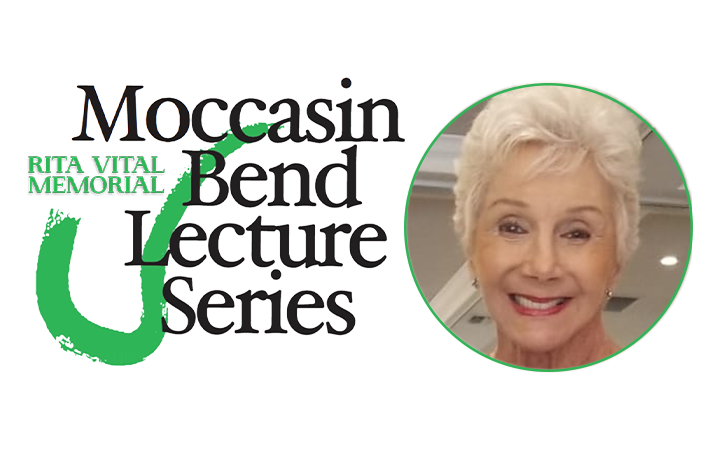
Upcoming Events

The Battles for Chattanooga: A Walking Tour Inside Point Park
From November 23 - 25, 1863, US and Confederate soldiers struggled to control the vital transportation hub of Chattanooga, Tennessee. This 30-45-minute program will help put the struggle for Chattanooga into perspective.

The Battles for Chattanooga: A Walking Tour Inside Point Park
From November 23 - 25, 1863, US and Confederate soldiers struggled to control the vital transportation hub of Chattanooga, Tennessee. This 30-45-minute program will help put the struggle for Chattanooga into perspective.
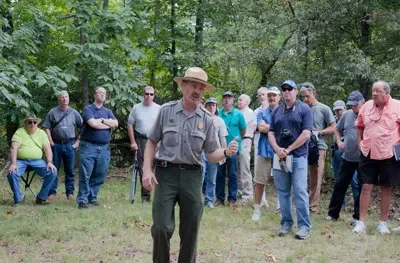
The Battle of Missionary Ridge at Tunnel Hill
William T. Sherman’s attack on the Confederate right was supposed to be Ulysses S. Grant’s winning strike against the Confederates in front of Chattanooga. Throughout November 25, 1863, Sherman launched repeated assaults. In this ninety-minute mile and a half walk, National Military Park Historian Jim Ogden will relate how Sherman’s attacks did not live up to Grant’s expectations.

A Driving Tour of the Battle of Missionary Ridge
On November 25, 1863, the US troops stormed the seemingly impregnable Missionary Ridge, routing the Confederate defenders and securing Chattanooga for the remainder of the war. This 90-minute car-caravan tour of Missionary Ridge will stop at the Iowa and Bragg Reservations, where insights into the November 25, 1863, actions will be shared.

The Battles for Chattanooga: A Walking Tour Inside Point Park
From November 23 - 25, 1863, US and Confederate soldiers struggled to control the vital transportation hub of Chattanooga, Tennessee. This 30-45-minute program will help put the struggle for Chattanooga into perspective.

Bragg, Hardee, Cleburne and the New Confederate Right
Just two days before, the Confederate right in front of Chattanooga had been more than a mile further to the south. But, with the initiation of the Federal offensive on November 23, 1863, a new Confederate right had to emerge and some of it didn’t until the Union attacks were underway. In this ninety-minute mile and a half walk, National Military Park Historian Jim Ogden will relate how this very new Confederate right came into existence and how it lay on the land.

The Battles for Chattanooga: A Walking Tour Inside Point Park
From November 23 - 25, 1863, US and Confederate soldiers struggled to control the vital transportation hub of Chattanooga, Tennessee. This 30-45-minute program will help put the struggle for Chattanooga into perspective.

The Battles for Chattanooga: A Walking Tour Inside Point Park
From November 23 - 25, 1863, US and Confederate soldiers struggled to control the vital transportation hub of Chattanooga, Tennessee. This 30-45-minute program will help put the struggle for Chattanooga into perspective.

The Battle of Lookout Mountain at Bald Hill
Union General Joseph Hooker’s demonstration along the lower reaches of Lookout Creek did much to prevent a meaningful response to the northerner’s simultaneous flank attack along the western slopes of the Lookout Mountain. The most significant landmark for many in this usually forgotten part of the “Battle Above the Clouds” was a prominent mostly open and cultivated hill. Join National Military Park Historian Jim Ogden for this 2 ½ hour 2 ½ mile walking tour of this less explored part of the Lookout Mountain Battlefield.

Greek and Already Met Greek: The Battle of Lookout Mountain at Cravens House
Among the rocky crags of Lookout Mountain, near the home of Robert Cravens, Confederate and Union forces met in a desperate struggle for control of the Lookout Mountain Turnpike, essentially the only way of retreat for Confederates occupying the mountain's summit. This 1-hour program will focus on the struggle around the "white house" on Lookout Mountain.

The Battles for Chattanooga: A Walking Tour Inside Point Park
Meet inside the Point Park Entrance Gate, 110 Point Park Road, Lookout Mountain, TN
From November 23 - 25, 1863, US and Confederate soldiers struggled to control the vital transportation hub of Chattanooga, Tennessee. This 30-45-minute program will help put the struggle for Chattanooga into perspective.

Sherman's Crossing and the Occupation of Billy Goat Hill
RiverPoint Trailhead on the Tennessee Riverwalk at Lost Mound Drive in the 3800 block of Amnicola Highway, Chattanooga, TN
An amphibious assault across the Tennessee to attack the Confederate right along Missionary Ridge was intended by Ulysses S. Grant to be his main offensive blow at Chattanooga in November, 1863. His most trusted subordinated, William T. Sherman, would lead the attack across the rain swollen river. Join National Military Park Historian Jim Ogden for this two-hour part walking part car caravan tour look at “Uncle Billy’s” efforts to implement his boss’s plan.

The Battle of Lookout Mountain at Bald Hill
Union General Joseph Hooker’s demonstration along the lower reaches of Lookout Creek did much to prevent a meaningful response to the northerner’s simultaneous flank attack along the western slopes of the Lookout Mountain. The most significant landmark for many in this usually forgotten part of the “Battle Above the Clouds” was a prominent mostly open and cultivated hill. Join National Military Park Historian Jim Ogden for this 2 ½ hour 2 ½ mile walking tour of this less explored part of the Lookout Mountain Battlefield.
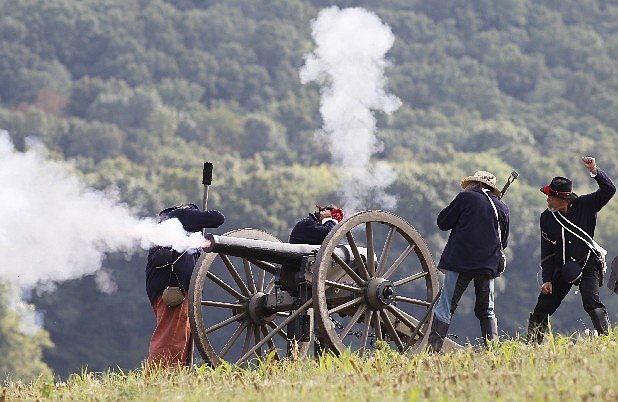
“Thunder on the Mountain” – Artillery Firing Demonstrations
LIVE ARTILLERY - Program Times: 1:30 pm & 2:30 pm
Artillery made Lookout Mountain important during the siege of Chattanooga. Using the heights to their advantage, Confederate batteries ensured no supplies were able to come into the beleaguered town. Then, they were involved in the defense of the mountain itself on November 24, 1863, in a battle in which the geography that earlier benefited them took a turn, and nature itself seemed to work against the gunners. These 30-minute programs will explore the role artillery played in the siege and in the “Battle Above the Clouds”.

The Battles for Chattanooga: A Walking Tour Inside Point Park
From November 23 - 25, 1863, US and Confederate soldiers struggled to control the vital transportation hub of Chattanooga, Tennessee. This 30-45-minute program will help put the struggle for Chattanooga into perspective.

The Battle of Orchard Knob: A Walking Tour
Meet inside the pedestrian gate located in the southeast corner of the Orchard Knob Reservation. Please park along Ivy Street.
On November 23, 1863, US soldiers, besieged in Chattanooga by surrounding Confederates since September, decided to strike back at the gray-clad troops occupying the heights around the city. The first military demonstration was against the small knoll between Chattanooga and Missionary Ridge, called Orchard Knob. This 1-hour program will provide insight into the first of 3 days of fighting to control Chattanooga.

"The Awe-Inspiring Precipice" - Infantry Presentations
LIVE INFANTRY PRESENTATIONS - Program Times: 10 am, 1 pm, 3 pm
In the early morning hours of November 25, 1863, Captain John Wilson and five men of the 8th Kentucky Infantry (US) ascending Lookout Mountain by climbing traversing the slopes from Cravens House to Point Lookout. Later, Captain Wilson stated, "Those who have seen the awe-inspiring precipice at the top of the great mountain can realize what a serious undertaking was before us...."
These 30-minute presentations will discuss the results of the Battle of Lookout Mountain and the eventual Union sucess that followed.

Brown's Ferry & Grant's Plan of Attack
The Tennessee River pontoon bridge at Brown’s Ferry was a critical link in any chain for final Union success at Chattanooga; the relative strength of that link significantly impacted Union Major General Ulysses S. Grant’s November, 1863, offensive to fully secure the “Gateway to the Deep South.” Join National Military Park Historian Jim Ogden for a one mile, ninety-minute round trip walk down to the river at Brown’s Ferry and learn how events at this vital crossing at the end of the third week of the eleventh month shaped what became the Battles for Chattanooga days later. The tour will begin along Moccasin Bend Road just north of Hamm Road; take Manufacturers Road west from US 27 and follow the Special Events signs.

The Battle of Lookout Mountain from Reflection Riding
“What ! Does the General expect us to fly?” That was the response of some Union soldiers when told early on November 24, 1863, that they would be attacking the Confederates on Lookout Mountain that day. The mountain’s seemingly indomitable height made the idea of such an attack to be almost as impossible as that of human flight. But their commander, Major General Joseph Hooker had taken the measure of his enemy in gray and devised a plan by which to wrest control of the mountain from the Confederates. Reflection Riding today protects ground where key parts of Hooker’s plan unfolded. Join Chickamauga and Chattanooga National Military Park Historian Jim Ogden for a guided 2 ½ mile, 2 ½ hour hike across the Riding to learn about those key parts of the “Battle Above the Clouds,” about the time when the peace and solitude of Reflection Riding was disturbed by fighting that was a part of one of the most important campaigns of the Civil War. This program is offered in partnership with Chickamauga and Chattanooga National Military Park and is part of the National Military Park’s series of programs commemorating the 162nd anniversary of the Battles for Chattanooga. Comfortable, supportive, footwear, clothing appropriate for the weather, and water are recommended for this program. The hiking pace between historical points will be approximately 2 ½ to 3 miles per hour.

You Take Command: Wargaming the Battles for Chattanooga in Miniature
No miniature wargaming experience is necessary, and children are welcome to participate with an accompanying adult. To reserve a spot for this event, contact Park Ranger Luke Dixon at luke_dixon@nps.gov. We hope to see you there!
Chickamauga and Chattanooga National Military Park will host an interactive, 3-hour, miniature wargame of the Battles for Chattanooga that will take place at the Chickamauga Battlefield Visitor Center. Up to 10 participants can take command of portions of the Federal and Confederate armies, making decisions and maneuvering military miniatures across a 3-dimensional tabletop battlefield as they seek to overcome some of the challenges faced by commanders during the real battles in November 1863.
Participants will determine the outcome of the battle as they each take on the role of an army, corps, or division commander during the climactic fighting at Lookout Mountain and Missionary Ridge on November 24 and 25, 1863. Players will work together using easy-to-learn rules to coordinate desperate assaults or spirited defenses to achieve victory. Dice rolls and event cards will help to determine the effects of combat, command and control, and the fog of war. If you would like to view the Battles for Chattanooga from a fresh perspective, or if you are interested in exploring the hobby of historical miniature wargaming, this program is for you!

The Battles for Chattanooga: A Walking Tour Inside Point Park
Meet inside the Point Park Entrance Gate, 110 Point Park Road, Lookout Mountain, TN
From November 23 - 25, 1863, US and Confederate soldiers struggled to control the vital transportation hub of Chattanooga, Tennessee. This 30-45-minute program will help put the struggle for Chattanooga into perspective.

“Thunder on the Mountain” – Artillery Firing Demonstrations
LIVE ARTILLERY - Program Times: 10:30 am, 11:30 am, 1:30 pm, & 2:30 pm
Artillery made Lookout Mountain important during the siege of Chattanooga. Using the heights to their advantage, Confederate batteries ensured no supplies were able to come into the beleaguered town. Then, they were involved in the defense of the mountain itself on November 24, 1863, in a battle in which the geography that earlier benefited them took a turn, and nature itself seemed to work against the gunners. These 30-minute programs will explore the role artillery played in the siege and in the “Battle Above the Clouds”.

"The Awe-Inspiring Precipice" - Infantry Presentations
LIVE INFANTRY PRESENTATIONS - Program Times: 10 am, 1 pm, 2 pm, & 3 pm
In the early morning hours of November 25, 1863, Captain John Wilson and five men of the 8th Kentucky Infantry (US) ascending Lookout Mountain by climbing traversing the slopes from Cravens House to Point Lookout. Later, Captain Wilson stated, "Those who have seen the awe-inspiring precipice at the top of the great mountain can realize what a serious undertaking was before us...."
These 30-minute presentations will discuss the results of the Battle of Lookout Mountain and the eventual Union sucess that followed.

A Vicious Little Battery: The Union Artillery on Moccasin Bend During the Siege and Battles for Chattanooga
The tour begins from a parking area along Moccasin Bend Road just north of the Moccasin Bend Mental Health Institute; look for the “Special Event” signs and the park ranger who will direct you into the parking area.
Union artillery, firing from fortifications on the southern-most hills of Stringer’s Ridge on Moccasin Bend, helped keep the Confederates at bay during the Siege of Chattanooga and then assisted in prying the Confederates from Lookout Valley and Lookout Mountain during the Battles for Chattanooga. Many of the earthworks that protected those Union cannon survive. Join Chickamauga and Chattanooga National Military Park Historian Jim Ogden for a two-hour walking tour through the complex and learn how “a vicious little battery” could essentially dominate the looming bulk of Lookout Mountain to the south.

162nd Anniversary of the Battles for Chattanooga
This year marks the 162nd Anniversary of the Battles for Chattanooga, and Chickamauga and Chattanooga National Military Park staff and volunteers plan to provide commemorative programs on November 22, 23, 24, and 25. Visitors wishing to participate in the park's programs are more than welcome to reference the schedule of events found below.
If you plan to attend some of the more strenuous walking tours, please keep in mind that comfortable, supportive footwear and clothing suitable for the weather are recommended, as is water. As a reminder, some of portions of the hiking routes may include grassy fields and less well-developed trails.
There is a $10 per person entrance fee to Point Park, on Lookout Mountain, for all adults ages 16 and older; children 15 and younger may enter for free. Programs occurring in other areas are FREE.
*Please note, programs are subject to staff availability and are subject to change.

The Rita Vita Memorial Moccasin Bend Lecture Series
Public Lands Partnerships: The Fort Monroe National Monument Model
The 20th Annual Rita Vital Memorial Moccasin Bend Fall Lecture Series concludes on Monday, November 10 at 7: 00 pm in the Tennessee Aquarium River Journey Auditorium.
Join us for an evening with Scott Martin, CEO, Fort Monroe Authority and Former Chattanooga Parks and Outdoors Administrator along with special guest, Hamilton County Historian Linda Moss Mines.
National Park Partners presents three unique Moccasin Bend Lecture Series events each fall with fascinating speakers and topics related to National Parks and conservation; Indigenous culture and history; and Chattanooga’s place in the U.S. Civil War. Founded in 2006, the series is underwritten by TN State Rep. Greg A. Vital and now celebrates its 20th anniversary thanks to his generous sponsorship.
All lectures are FREE and open to the public.
Recordings of previous lectures are available on-demand on our YouTube Channel.
Fort Monroe National Monument is the outgrowth of a beautiful partnership between the nonprofit Fort Monroe Authority, the National Park Service, and the City of Hampton, Virginia. Together these organizations maintain selected portions of the 565 acre park, providing tourists and residents with pleasant experiences all year round. Mr. Martin will outline how the partnership began, how its changed throughout the years, and how the best practices of this model for public lands management may be replicated in other communities. He will be introduced by Linda Moss Mines, who will share updates on activities in Chattanooga and Hamilton County currently being planned for the American 250 celebrations in 2026.
Prior to becoming the CEO of Fort Monroe Authority last December, Scott Martin served as Administrator of the Department of Parks and Outdoors (DPO) for the City of Chattanooga. He guided the development of the first comprehensive DPO plan in over 25 years, engaging more than 5,000 residents in the process, and helped secure $8.4 million in philanthropic and public funding for parks and recreation. Previously, Martin served as Executive Director of the River Heritage Conservancy in Indiana, where he led efforts to establish a 4,400+ acre urban park system celebrating the historic Falls of the Ohio River. Martin’s experience also includes serving as Parks Director for 21st Century Parks in Louisville, Kentucky, where he helped develop a 4,000-acre nonprofit-run park system. Earlier in his career, Martin was the first Director of Franklin County (VA) Commerce & Leisure Services. Martin holds a Bachelor of Arts in Political Science and a Master of Public Administration from Boise State University. He is a Fellow of the American Academy for Parks and Recreation Administration, serves as North American Chair for World Urban Parks, and is recognized internationally for his work integrating conservation, recreation, and economic development in urban settings.
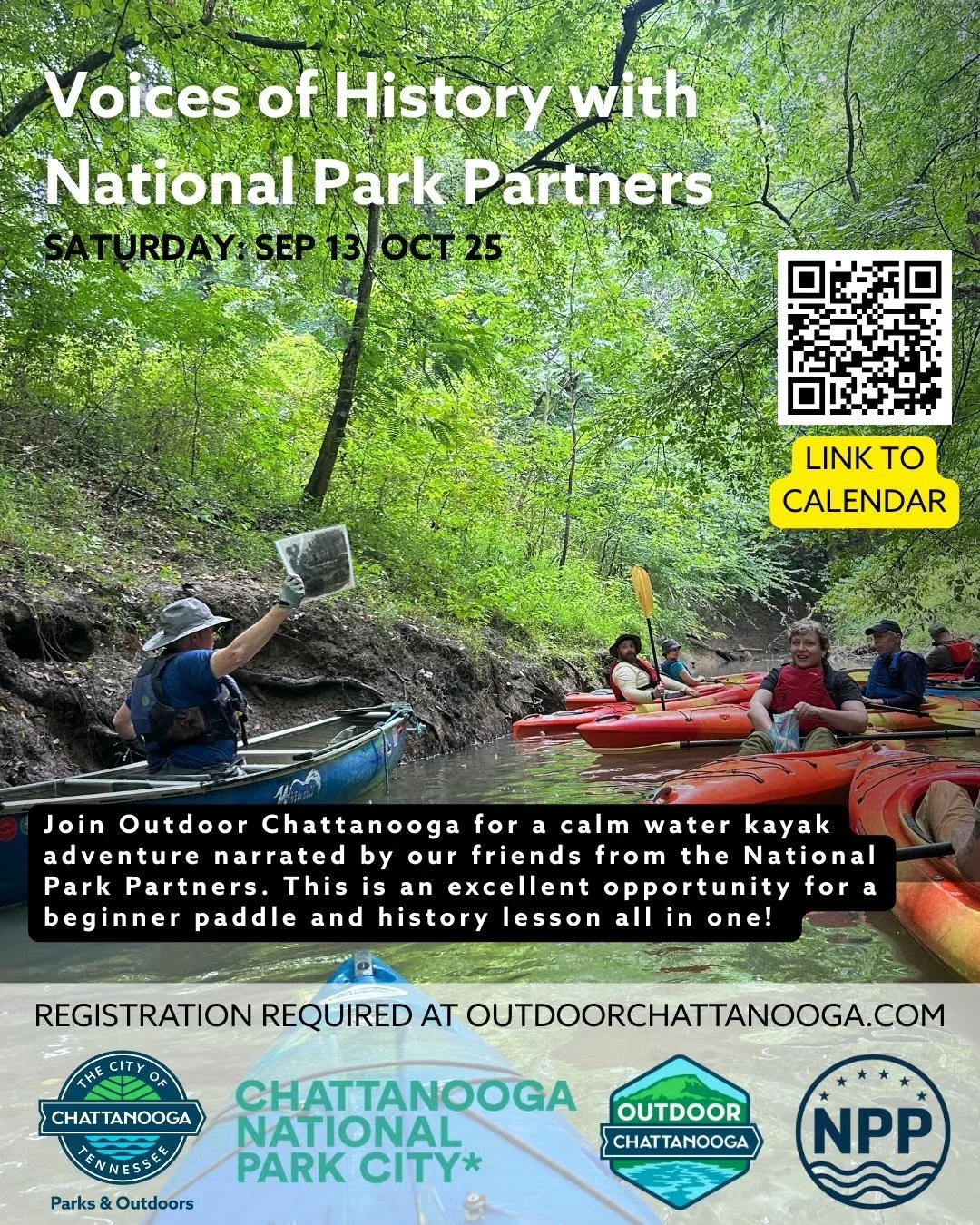
History by Kayak
This kayak tour on Lookout Creek and the Tennessee River is rich in history. National Park Partners historians have partnered with Outdoor Chattanooga to provide this unique opportunity for recreation and immersive learning.
In the early morning hours of October 27, 1863, fifteen hundred Union soldiers boarded boats in Chattanooga and floated down the Tennessee River to conduct a successful amphibious assault at historic Browns Ferry. This program emulates the action at Browns Ferry and the Opening of the Cracker Line as we paddle in kayaks down the Tennessee River and land at historic Brown’s Ferry. The paddle is four miles in length and will take approximately three hours. Kayaks, PFDs, paddles, guides and transportation back to your vehicle all will be provided by Outdoor Chattanooga. The program also includes a visit to Browns Tavern, the oldest building in Hamilton County, prior to the paddle.
Appropriate for ages 16 and up. Some kayak experience is helpful but not required. Pre-registration is required. Cost: $35 per person. Space is limited.
As a reminder registration opens 2 weeks before the event and closes two days before!
For more information call 423-387-LEAF (5323) or email us at info@outdoorchattanoga.com

The Rita Vita Memorial Moccasin Bend Lecture Series
The Relevance of Community Involvement in a National Park City
The 20th Annual Rita Vital Memorial Moccasin Bend Fall Lecture Series continues on Monday, October 20 at 7: 00 pm in the Tennessee Aquarium River Journey Auditorium.
The speakers for the evening will be M. Ann Belkov, retired, National Park Service, Former Superintendent of Chickamauga and Chattanooga National Military Park (CCNMP) and special guest, Chattanooga Mayor Tim Kelly.
National Park Partners presents three unique Moccasin Bend Lecture Series events each fall with fascinating speakers and topics related to National Parks and conservation; Indigenous culture and history; and Chattanooga’s place in the U.S. Civil War. Founded in 2006, the series is underwritten by TN State Rep. Greg A. Vital and now celebrates its 20th anniversary thanks to his generous sponsorship.
All lectures are FREE and open to the public.
Recordings of previous lectures are available on-demand on our YouTube Channel.
During her tenure as CCNMP Superintendent, Ann Belkov accomplished three major feats that distinguish her among past superintendents and remain highly relevant today. She organized the Friends of CCNMP, which began fundraising in 1986 for the expansion of the Visitor Center at Chickamauga Battlefield. Following that success, she rallied support for the restoration and installation of the James Walker mural in the new Visitor Center at Lookout Mountain Battlefield (the painting had been in a storage shed for more than 35 years). Finally, almost alone, she prevented a four-lane divided highway from being constructed through the middle of Chickamauga Battlefield.
Retired Superintendent Belkov will discuss how community engagement was instrumental in these and other major accomplishments in the past, and how essential it continues to be given the National Park Service's current staffing and budget challenges. She and Mayor Kelly will describe the potential for linking Chattanooga's National Park City designation with the tremendous resources of Chickamauga and Chattanooga National Military Park, including Moccasin Bend National Archeological District.
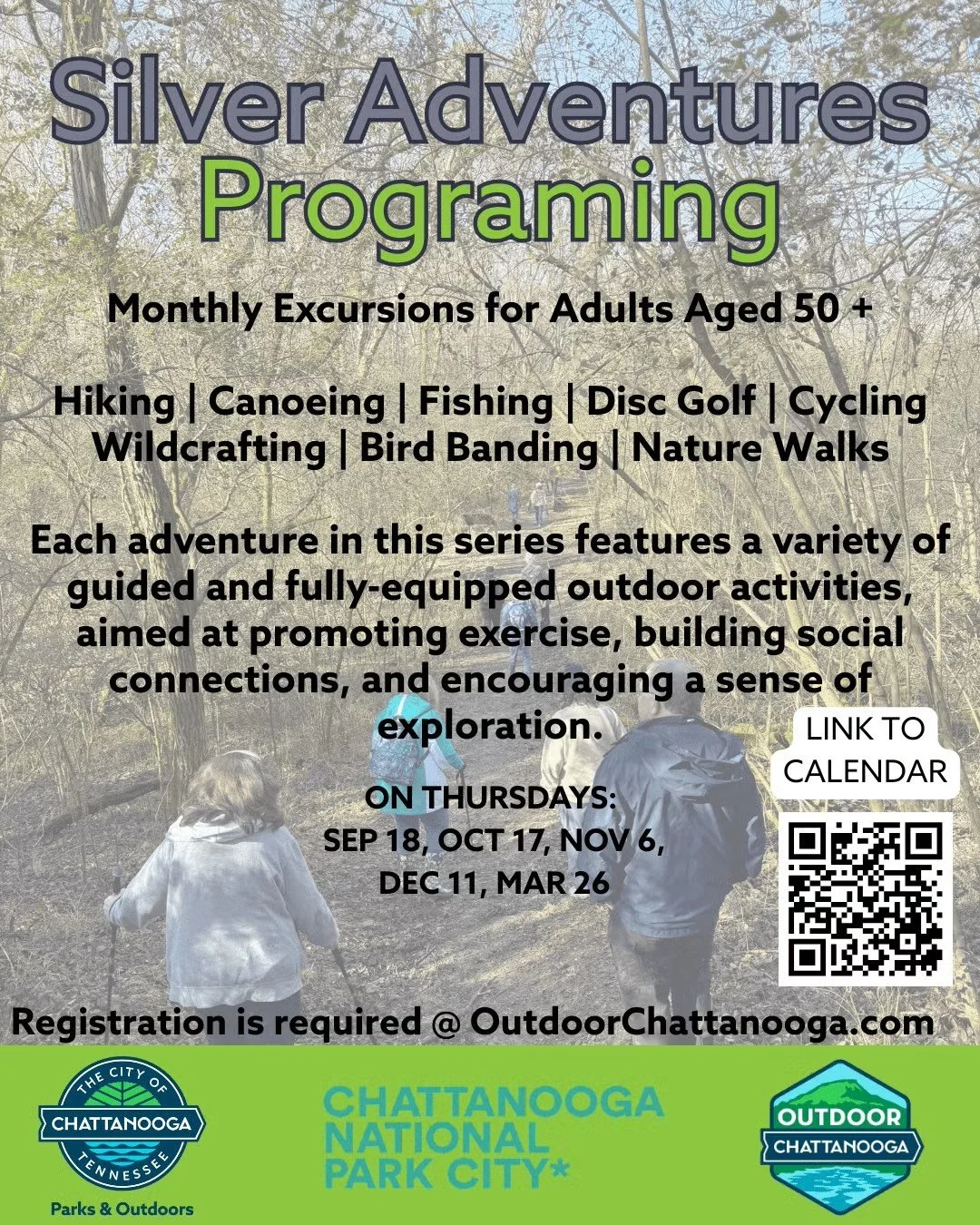
History Walk with Outdoor Chattanooga
Discover the wonders of the great outdoors with Outdoor Chattanooga’s Silver Adventures, for adults aged 50 and above.
Step back in time and explore the historic landscape of Brown’s Ferry and the Federal Road on this engaging guided walk. The trail is rated easy, and is about 1.2 miles round‑trip (out & back) with some uneven ground.
Led by a Chickamauga Chattanooga National Park interpretive ranger, this tour traces one of the most important early transportation routes in the region—used by Native American tribes, settlers, soldiers, and traders. Discover the stories behind Brown’s Ferry, a strategic river crossing during the Civil War, and learn how the Federal Road shaped the development of Chattanooga and the surrounding areas.
Registration is required. Van carpooling may be necessary due to limited parking at the trailhead. Additional information will be shared to your registration email a couple days prior to the program.
As a reminder registration opens 2 weeks before the event and closes two days before!
For more information call 423-387-LEAF (5323) or email us at info@outdoorchattanoga.com

“A Living Sheet of Fire”: John T. Wilder’s Lightning Brigade at Chickamauga
ALL RANGER LED EVENTS ARE POSTPONED PENDING THE END OF THE GOVERNMENT SHUTDOWN
Few units that fought at the Battle of Chickamauga spark as much curiosity as Union Colonel John T. Wilder’s brigade of mounted infantry. Nicknamed the “Lightning Brigade” for the seven-shot Spencer repeating rifles with which they were armed, these hard-fighting soldiers from Indiana and Illinois found themselves heavily engaged on all three days of the battle.
This ranger-led car caravan tour will examine the actions of the Lightning Brigade on each day of the Battle of Chickamauga. Interested visitors should meet at the Chickamauga Battlefield Visitor Center at 10 am for the program introduction.
The program will involve a bit of walking over uneven ground, so participants are advised to wear sturdy shoes and to bring a bottle of water.
We hope to see you there!


